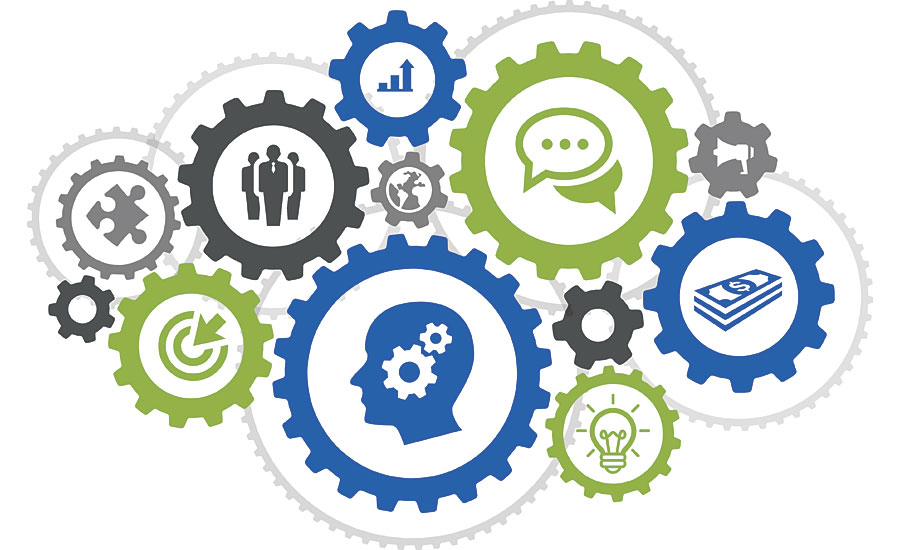Supplier Relationship Management
Delivers the Secret Sauce for Paint and Coatings Businesses

In today’s global marketplace, success requires paint and coatings companies to pay attention to their supplier relationships and work with suppliers who will contribute to the long-term success of their business and the business of their customers. Making sure that the relationship with these suppliers runs smoothly and provides value for all is a key factor that leads to bottom-line profits. Supplier relationship management (SRM) is the approach to managing and interacting with your supplier to maximize the value of the partnership, minimize risk and manage costs through the entire supplier relationship lifecycle. The goal of a SRM program is to drive the ideal balance of inventory, working capital and service levels.
The program is enabled by a SRM solution that can be used to foster collaboration among buyers and sellers. The software automates the transactions of buying and selling over a robust network. It collects transactional information that can be used to measure key performance indicators of inventory, transportation, service levels and more. A SRM system drives value for both parties, resulting in lower costs, reduced risk, greater efficiencies and better quality.
SRM programs create a common frame of reference to enable effective communication between an enterprise and suppliers who may use quite different business practices and terminology. As a result, SRM programs increase the efficiency of processes associated with acquiring goods and services, managing inventory and processing materials.
Automating key business processes, such as procure-to-pay, order or vendor inventory management improves collaboration and communication among supply chain trading partners and is the foundation for an effective supplier relationship management program. Having suppliers, buyers and trading partners connect to a supply chain operating network fosters this automation and leads to reduced costs and errors. But how do you know which suppliers to work with?
The Secret Sauce
Paint and coatings companies typically work with a strategic group of suppliers that can help them bring innovative, new and better products to market. Collaboration and communication among these partners becomes the “secret sauce” that leads to a competitive advantage for your business. The chemical basis for a coating has not changed for a long time; what has changed is the different special chemicals that enhance the product to create something that will get their customer a better product. This is the “special sauce”, a combination of molecules that could make the product last longer, more environmentally friendly, dry quicker, coat more evenly and so on. For example, if you manufacture paint for the aerospace business, you could have a relationship with a supplier who produces special ingredients that can reduce heat levels of products. By collaborating with the supplier and working together, you could co-develop a paint that withstands high temperatures, allowing an airplane to climb to even higher altitudes. Now you are the only business that manufactures this type of paint; this intellectual property delivers unprecedented value to clients, leading to greater profitability.
In this scenario, collaboration and communication with the supplier was a critical component of success. SRM allowed the business to deliver an innovative product to market, giving them a competitive edge. Speed to market, collaboration on quality improvements and new product innovations are all benefits of good SRM.
What to Look for in an SRM System
This may be tautology, but the bottom line is you need something that can help you with your supplier relationships. The importance to this is how you want to view your suppliers. This is different from industry to industry. For the paint and coatings industry, it may be important that your supplier delivers on time and in full, but it also may be important that they spend money on R&D to help you with your special sauce. Critically, it is not just for your current suppliers, but systematically comparing them to the wider market to see if they are still the best bet for you in the future.
Using SRM technology provides you with full and unparalleled visibility into your supplier base, giving you a detailed picture of what is impacting your supply chain and making it easy to mitigate the risk. SRM software contains invaluable features and performs tasks for you, such as updating suppliers’ profiles, managing and monitoring supplier performance, and identifying and accommodating new suppliers. The more vendors you work with, the harder it is to keep track of them, which is why SRM software makes it easier by containing all your supplier information in one centralized location.
However, before you get started with an SRM system, you need to first identify the suppliers that will be part of this program. This requires you to put in place a good supplier selection criterion. The idea is to identify suppliers where the power balance is well distributed and it is in both parties’ interests to collaborate.
You also need to establish quantitative measures of supplier activities: percentage of deliveries on time, proportion of orders delivered complete, quality of goods delivered, etc. These are the kind of performance indicators that are regularly used in assessing supplier relationships.
A supply relationship management system should encompass:
- Supplier Portfolio Management and Segmentation – Understanding the differences between your suppliers. This involves determining what your technical capabilities are (IT, forecasting, etc.), which suppliers will have the largest impact on your program (ROI), what procurement execution processes are available (standard order to pay, vendor-managed inventory), and what approach to take to generate the positive momentum necessary to help drive the change management effort. This exercise is critical to building an effective supplier portfolio.
- Relationship Governance Management – Defined roles and responsibilities of each stakeholder. This also involves a level of mutual trust between partners, but you should always monitor your suppliers to confirm they are complying with your corporate standards and ethics. The tools to ensure openness and disclosure when used, like monitoring critical control points, will catch problems before they occur.
- Performance and Risk Management – establish quantitative measures of supplier activities: percentage of deliveries on time, proportion of orders delivered complete, quality of goods delivered, etc. These are the kind of performance indicators that are regularly used in assessing supplier relationships.
- Supplier Certification and Development – Supplier certification starts with a formal performance evaluation by a cross-functional team to assess a supplier’s strategic fit and capability across very specific criteria – things like commodity criticality, performance to a defined quality level, long-term reliability, cost and innovation. This process helps pinpoint suppliers that can bring the most value and remain competitive over the long term.
What needs to be added to this list of capabilities is the very simple fact that it must be easy to use. A buyer should be able to extract information easily without having to refer to the manual. The master data must be simple to input, if possible you should be able to move this task to your suppliers. SRM systems can quickly go out of date if they are not well managed. A good SRM system is managed like a fine garden. Simple tasks, on a regular basis, will keep it providing you with the information you need.
Benefits of a Successful Supplier Relationship Management Program
We’ve touched on some of the benefits for a SRM, which include lowering costs, streamlining operations and balanced service levels. Another benefit is when there is a shortage of supplies due to a labor strike, power outage, natural disaster or other risk, having a priority relationship with your suppliers, means your business can continue operation without an interruption in supply because you will continue to get products.
Successful SRM yields a faster time to market, transactional efficiency, competitiveness, risk management, and large financial gains – all of which not only contribute to your bottom line, but also allow you to deliver a quality and cutting-edge product, putting you ahead of the market. Another key benefit of enhanced SRM capabilities is the ability to conduct regular spend assessments. This helps a business better understand what they are spending for what they are getting, enabling accurate comparisons to other suppliers’ offerings.
In the case of one $17 billion manufacturer, by working with suppliers and implementing a vendor-managed inventory strategy, the company saved over $40 million in working capital and automated fulfillment for over 90% of their direct material purchases. In another case, a leading CPG company implemented a predictive forecasting system that increased inventory replenishment accuracy from less than 55% to greater than 80%. This allowed both the buyer and the suppliers to reduce safety stock levels by 20%.
Effective supplier relationship management starts with understanding your internal capabilities, your supply base, and the collaborative technologies that are available to drive down working capital while increasing service levels. A holistic alignment with suppliers is needed across the corporation to ensure a seamless flow of high-quality goods to the right place at the right time. By automating with the right suppliers, your business can reduce administrative burden and errors, gain visibility into what is happening, and drive down costs.
Best Practices for SRM
Five best practices for supplier relationship management include:
1. Renegotiate contracts on a regular basis. Depending on your industry and type of commodities purchased, this may happen quarterly, annually or even as infrequently as every few years. However, for long-term suppliers that you have a strategic relationship with, particularly for direct materials and critical commodities, it’s a good practice to revisit cost and quality improvement targets at least annually. Single sourcing from a strategic supplier yields long-term contracts and hence a long-term, successful relationship.
2. Treat suppliers with a win-win perspective that can drive innovation and competencies, leading to a competitive edge for both parties. In a collaborative relationship, buyers and suppliers share a long-term commitment to improving each other’s capabilities by openly working together to lower costs and improve efficiencies.
3. Be a good customer. Commit to buying in volume, sharing forecasts so suppliers know your requirements for inventory, providing suppliers with options on freight and packaging and paying invoices on time makes your business a good customer for suppliers, and a business they will want to commit to. Aggregating volume across the organization and bundling those purchases under the same supplier gives a business better negotiating power. Talk to them about what is important for your customers, then they will share empathy with your company’s needs.
4. Make your business easy to do business with. Every company has its own processes and enterprise requirements. Giving suppliers real-time visibility into your requirements helps them plan better and adjust to changes when they happen. By automating day-to-day transactional information, you and your suppliers can spend your time working on the things that really matter, such as innovative design. No supplier wants to accidentally perform poorly. Automation ensures data quality, removing human error from the equation.
5. Help suppliers work more efficiently. When suppliers have visibility into your demand, they are generally more efficient. Collaborative supply programs like consignment arrangements, vendor-managed inventory, and demand planning and collaborative forecasting between suppliers and buyers allow both partners to streamline their work processes and benefit from a more accurate forecast, optimal inventory levels, and greater supply stability. The more a supplier considers the customer’s customer, the more efficient they will be.
For more information, visit www.elemica.com.
Looking for a reprint of this article?
From high-res PDFs to custom plaques, order your copy today!







